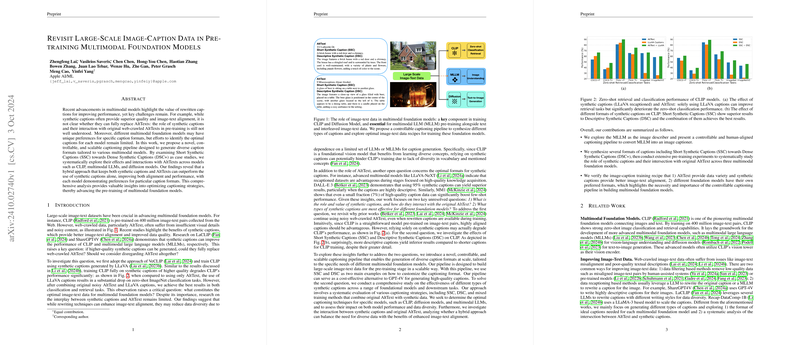An Analytical Overview of Image-Caption Data in Multimodal Model Pre-training
This paper examines the nuanced dynamics of large-scale image-caption datasets in the pre-training of multimodal foundation models. The authors propose a innovative, controllable, and scalable captioning pipeline designed to generate diverse caption formats, aiming to improve image-text alignment for various models like CLIP, multimodal LLMs, and diffusion models. The pipeline's efficacy is evaluated through extensive pre-training experiments, which reveal significant insights into optimizing captioning strategies.
Key Contributions and Findings
- Hybrid Approach for Optimal Performance: The paper explores the hybrid use of synthetic captions and AltText, highlighting that such a combination can outperform the use of either source alone. This approach enhances both image-text alignment and data diversity, crucial for models such as CLIP.
- Caption Formats and Model Preferences: Different models exhibit distinct preferences for caption formats. Short Synthetic Captions (SSC) appear to benefit CLIP, boosting retrieval performance, while the more descriptive Dense Synthetic Captions (DSC+) are advantageous for pre-training multimodal LLMs. Remarkably, after the SFT stage, DSC+ alone demonstrates superior results among MLLMs, underscoring the importance of detailed captions in deep vision-language understanding.
- Role of Synthetic Captions in Diffusion Models: The paper aligns with prior findings from DALL-E 3, indicating that detailed captions can improve the prompt-following capabilities of diffusion models. This was validated using benchmarks like GenEval and DSG, where synthetic captions notably enhanced performance.
- Balanced Data Recipe: The paper identifies an optimal mixing ratio of synthetic captions and AltText, achieving the best results when using around 40-50% of each for CLIP training. This mixture effectively combines the breadth of knowledge inherent in AltText with the enhanced alignment offered by synthetic captions.
Practical and Theoretical Implications
The insights provided by the paper suggest practical applications in the development of multimodal foundation models. The controllable captioning pipeline offers a cost-effective means of generating high-quality image captions, potentially serving as a scalable alternative to more resource-intensive solutions like GPT-4V. Furthermore, the findings argue for a more tailored approach to image-caption data in model pre-training, emphasizing the importance of aligning data format with model architecture.
Theoretically, this work challenges the notion that better-aligned synthetic captions can completely replace traditional AltText. It posits that while synthetic data improves alignment, the diverse and broader knowledge base of AltText contributes significantly to foundational learning, especially for classification tasks in models like CLIP.
Future Developments in AI
Future research may focus on further refining captioning pipelines to minimize hallucinations while maximizing both richness and accuracy. Additionally, studies could explore specific downstream applications of multimodal models to understand the broader impacts of caption variability. Such efforts could lead to an improved understanding of the cognitive processes underpinning multimodal language processing and provide a foundation for more generalized AI systems. Continued exploration into the integration and optimization of image-caption data will be essential as AI advances, particularly in enhancing models' abilities to navigate and synthesize across complex, real-world datasets.
Conclusion
The paper offers valuable insights into the role of image-caption data in the development of multimodal foundation models. Its novel approach to understanding and optimizing captions according to model needs and performance metrics provides a significant contribution to the field, fostering a more nuanced appreciation of the intersection between data diversity and alignment in AI pre-training.
